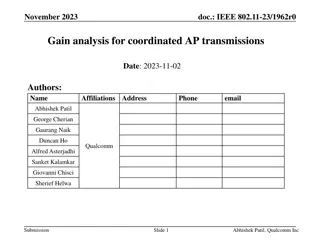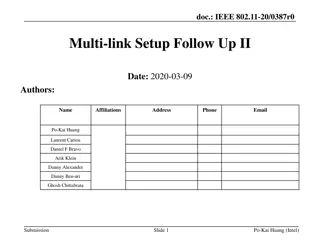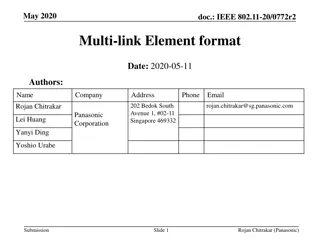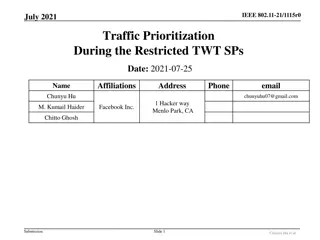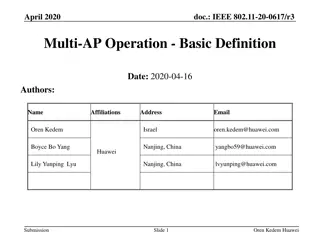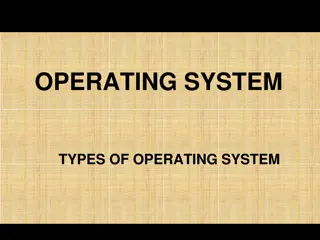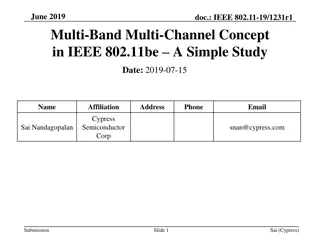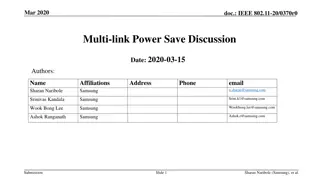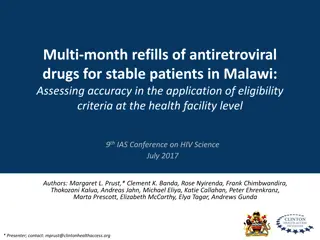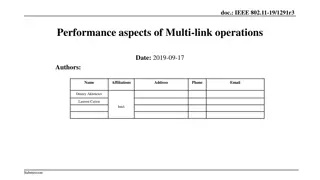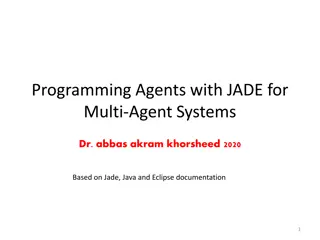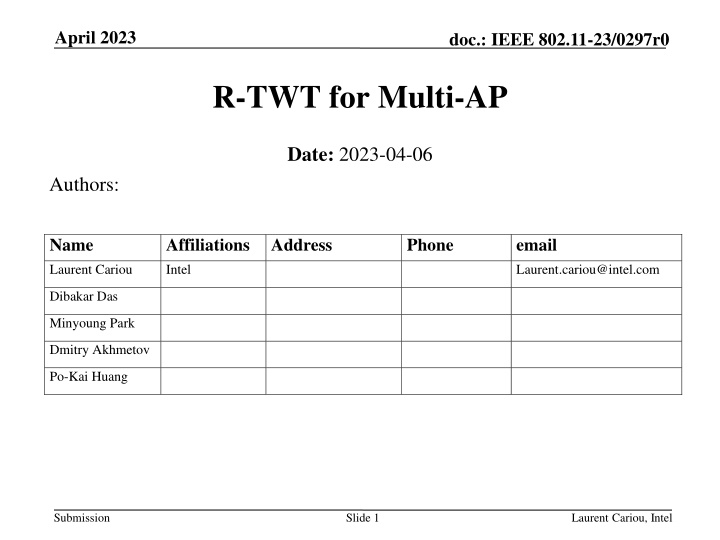
IEEE 802.11-23/0297r0 R-TWT for Multi-AP Scenarios Analysis
Explore the potential of using the Restricted-TWT (r-TWT) tool in Multi-AP environments. Investigate its effectiveness in enhancing QoS and coordination among overlapping BSSs. Analyze the applicability of r-TWT functionalities like creating contention periods for improving Multi-AP modes. This study delves into optimizing latency-sensitive traffic transmission in complex wireless setups.
Download Presentation

Please find below an Image/Link to download the presentation.
The content on the website is provided AS IS for your information and personal use only. It may not be sold, licensed, or shared on other websites without obtaining consent from the author. If you encounter any issues during the download, it is possible that the publisher has removed the file from their server.
You are allowed to download the files provided on this website for personal or commercial use, subject to the condition that they are used lawfully. All files are the property of their respective owners.
The content on the website is provided AS IS for your information and personal use only. It may not be sold, licensed, or shared on other websites without obtaining consent from the author.
E N D
Presentation Transcript
April 2023 doc.: IEEE 802.11-23/0297r0 R-TWT for Multi-AP Date: 2023-04-06 Authors: Name Laurent Cariou Affiliations Intel Address Phone email Laurent.cariou@intel.com Dibakar Das Minyoung Park Dmitry Akhmetov Po-Kai Huang Submission Slide 1 Laurent Cariou, Intel
April 2023 doc.: IEEE 802.11-23/0297r0 Multi-AP scenarios In previous generations, we have improved efficiency (scheduling, ) and reliability for Latency-sensitive traffic by considering mostly a single BSS The goal of AP coordination is to extend these enhancements by considering multiple overlapping BSSs Simplest scenario is when all these OBSSs are from the same management domain (same ESS): typical enterprise deployment (calling this scenario a managed OBSS scenario) More complicated scenario, but not less useful, is when OBSSs are not part of the same management domain (calling this scenario an unmanaged OBSS scenario) Note that we consider P2P or mobile APs also as part of this coordination Since 11be, we have investigated several mechanisms to improve coordination between neighboring APs (mainly for managed OBSS scenario) Those are mainly based on one AP gaining a TxOP and sharing that TxOP with overlapping APs in time (C-TDMA), frequency (C-OFDMA) or space (C-SR) and possibly with some more advanced PHY coordination. At least some of those modes (if not all) will be defined in UHR The KPIs for these modes are very diverse: throughput, efficiency, reuse, latency, Submission Slide 2 Laurent Cariou, Intel
April 2023 doc.: IEEE 802.11-23/0297r0 R-TWT tool In 11be, we have defined Restricted-TWT (r-TWT) Goal was primarily to increase the probability to access the medium and transmit low latency traffic The r-TWT tool is basically doing the following: Forcing STAs from the BSS to stop their ongoing TxOP before the start of the r-TWT SP Creating a contention period at the start of the r-TWT SP and increasing the chances that the AP will gain the TxOP and schedule critical traffic during the SP. Submission Slide 3 Laurent Cariou, Intel
April 2023 doc.: IEEE 802.11-23/0297r0 R-TWT for Multi-AP scenarios In this contribution, we investigate how the r-TWT tool ( as is or modified) can be useful for Multi-AP deployments There are 2 main angles to this: 1) Can we extend the protection (or increased probability to meet the QoS requirement of some traffic) that r-TWT tool is providing within a BSS to multiple overlapping BSSs 2) Can the r-TWT functionality of creating a contention period at a relative precise time be useful to help also for the other Multi-AP modes (C-TDMA/FDMA/SR ) or M-AP objectives Submission Slide 4 Laurent Cariou, Intel
April 2023 doc.: IEEE 802.11-23/0297r0 1a) Extend r-TWT protection rules to OBSSs An AP (AP1) is advertising an rTWT SP1 so that all EHT STAs supporting r-TWT shall end their TxOP before the start of an rTWT SP A coordinated OBSS (AP2) could advertise an OBSS rTWT SP that overlaps in time with rTWT SP1 so that its associated STAs also respect that rule (end their TxOP before the start of the rTWT SP) rTWT SP advertised by AP2 would be in reference to the TSF of AP2, but be coordinated so that it overlaps in time with rTWT SP1 Proposed in 11be but so far not accepted Additional rule to define would be that the OBSS (AP2) would also have to respect the rule (end the TxOP before the start of the rTWT SP) Submission Slide 5 Laurent Cariou, Intel
April 2023 doc.: IEEE 802.11-23/0297r0 1a) Extend r-TWT protection rules to OBSSs Signaling to enable this in a TWT element is quite straightforward Just an explicit signaling that the TWT SP is for an OBSS Ensuring no drift of OBSS rTWT SPs compared to the rTWT SP1 requires some discussion TSF alignment between OBSSs, TSF drift estimation and rTWT timing correction, Another challenge is obviously that most of/all the OBSSs (and their associated STAs) will support this and accept to extend that protection For managed scenarios, the APs will be coordinating through the common management entity. So no need to define anything in UHR. For unmanaged scenario, we will need to define in UHR the negotiation (Request/Response) between OBSSs in order to enable this advertisement. We obviously need to find the right incentives to push unmanaged APs/P2Ps to coordinate and trust each other If, among 2 OBSSs that negotiate, each OBSS gets a protection extension for one of its rTWT SP, it would be a Win-Win situation Submission Slide 6 Laurent Cariou, Intel
April 2023 doc.: IEEE 802.11-23/0297r0 1b) Multiplexing in time rTWT SPs from OBSSs If 2 OBSSs want to establish rTWT SPs for some of their traffic, they can coordinate in order to make sure that each rTWT SP will not overlap with the rTWT SP of the neighbor Similarly, 2 overlapping Mobile APs/P2Ps can coordinate the SPs during which they are Active/Inactive in order to be as alone as possible on the medium during operation. This can be naturally achieved as the rTWT SPs and the Active/Inactive SPs are/will be advertised in Beacon frames and therefore can be seen by OBSSs We could obviously define rules/recommendations for APs to monitor the Beacon frames from OBSSs We should also define in UHR negotiation (Request/Response) between OBSSs in order to better coordinate the time sharing between OBSSs Incentives here can be for better reliability, but also power save, efficiency, Submission Slide 7 Laurent Cariou, Intel
April 2023 doc.: IEEE 802.11-23/0297r0 2) r-TWT to assist/enable C-TDMA/C-OFDMA/C-SR First interest to consider is that if 2 APs are advertising r-TWTs for themselves and that are overlapping, we increase the chance that there will be an aligned contention period on the 2 APs contention domain If the 2 APs are operating on the same primary channel, there is a probability increase that at least one of them will get access to the channel. If the 2 APs are operating on the same bandwidth but with different primary channel, the probability increase to access the channel on the wider bandwidth is now considerably increased (see next slide) If those 2 APs also intend to apply a coordinated mechanism (C-TDMA, C- OFDMA, C-SR) during the r-TWT SP, they will then both benefit from gaining the TxOP at that time. Note that here, the usage of r-TWT SP as an additional tool for C-TDMA/C-FDMA/C-SR is not only for latency-sensitive traffic but also for more general M-AP KPIs like efficiency/throughput, Submission Slide 8 Laurent Cariou, Intel
April 2023 doc.: IEEE 802.11-23/0297r0 Illustration with a scenario of interest for enterprise In enterprise scenarios, the fractional frequency reuse concept is a compelling target (among others): - Enable Spatial Reuse on entire BW to/from STAs close to the center of the BSSs (where there is less interference from neighbor OBSSs) - Do FDMA/OFDMA or TDMA to/from STAs close to the edge of the BSS (where there would be higher interference from neighbhor BSSs): avoid interference AP1 AP1 AP1 AP2 Primary channel AP1 40 MHz AP2 40 MHz Primary channel Submission Slide 9 Laurent Cariou, Intel
April 2023 doc.: IEEE 802.11-23/0297r0 Illustration with a scenario of interest for enterprise A typical scenario where we could use FFR is with 2 APs operating on the same BW but with different primary channel Different primary channels in order to allow frequency reuse and interference avoidance also in presence of legacy STAs In such scenario, there are 2 contention domain on the 2 channels and the chances of doing 40 MHz channel access is very limited, which will highly limit AP coordination schemes 20 MHz PPDU AP1 20 MHz PPDU AP1 AP1 Sc Pc 40 MHz PPDU AP1 40 MHz 40 MHz AP2 20 MHz PPDU AP2 20 MHz PPDU AP2 Sc Pc Submission Slide 10 Laurent Cariou, Intel
April 2023 doc.: IEEE 802.11-23/0297r0 Illustration with a scenario of interest for enterprise If we ensure start of TxOP (and contention periods) alignment of the 2 BSSs thanks to coordinated rTWTs (advertisement by both APs of an overlapping r- TWT), we then highly increase the chances that channel access is gained on the wide BW for the group of coordinated APs. 20 MHz PPDU AP1 20 MHz PPDU AP1 20 MHz PPDU AP2 AP1 40 MHz PPDU AP1 Sc Pc 40 MHz PPDU AP1 40 MHz 40 MHz AP2 20 MHz PPDU AP2 Sc Pc Same rTWT for AP1 and AP2 We can then define periods of time where M-AP coordination will be possible We can also easily define periods of time during which C-SR or more advanced coordinated PHY modes on the entire bandwidth will be used, and periods of time where operation will be limited to lower bandwidth for interference avoidance Submission Slide 11 Laurent Cariou, Intel
April 2023 doc.: IEEE 802.11-23/0297r0 2) r-TWT to assist/enable C-TDMA/C-OFDMA/C-SR Second interest to consider (more exploratory at this stage) is that we could use r-TWT SPs to configure/schedule the mode of operation during the SP across multiple OBSSs Operating BW during the rTWT SP for previous FFR example: one rTWT with 20MHz operating BW for interference avoidance (each BSS on its primay channel), one rTWT for 40 MHz operating BW for M-AP reuse (both BSSs on the 40MHz channels) Other possible constraints to consider and analyze: limiting SP to DL or UL only, channel access restrictions for APs and STAs, role distributions (Sharing AP/Shared AP), transmit power or PSD limits And/or to select the members (STAs) of an rTWT SP to match the purpose of the rTWT SP above rTWT ID allowed to be set to 0 to cover all BSS To limit membership, with baseline tools or with automatic membership under conditions RSSI to serving AP limit, RSSI to OBSS AP, ACs / TIDs / SCSs, Submission Slide 12 Laurent Cariou, Intel
April 2023 doc.: IEEE 802.11-23/0297r0 Example of time split with rTWT coordination for FFR AP1 AP1 AP1 AP2 Primary 20 MHz TWT 40 MHz TWT Primary channel AP1 Sharing AP 40 MHz TWT Primary 20 MHz TWT AP2 Primary channel Shared AP Submission Slide 13 Laurent Cariou, Intel
April 2023 doc.: IEEE 802.11-23/0297r0 Conclusion Coordinated rTWT allows 1) to extend the protection (i.e. increased probability to meet the QoS/latency requirement of some traffic) that r-TWT tool is providing within a BSS to multiple overlapping BSSs. Features needed: signaling in rTWT element for OBSS rTWT Solution to prevent drifts between rTWT SP Negotiation between APs to coordinate rTWT between unmanaged OBSSs 2) to help other M-AP coordination techniques by increasing the chances of channel access on a wider BW and to define periods for different types of M-AP techniques. Features needed: Solution to prevent drifts between rTWT SP Feature to explore: Signaling for M-AP operating mode and members selection within rTWT Submission Slide 14 Laurent Cariou, Intel
April 2023 doc.: IEEE 802.11-23/0297r0 Annex Submission Slide 15 Laurent Cariou, Intel
April 2023 doc.: IEEE 802.11-23/0297r0 Illustration of Frequency reuse 7 at 6 GHz Here, we assume that: we keep frequency reuse 7 Distance between OBSSs is therefore much larger than BSS size AP2 Depending on BSS size and propagation, there could be zones in the BSS where interference between OBSSs needs to be avoided, and zones where interference can be tolerated AP1 As STAs from different OBSSs are quite far away, FDMA will likely be sufficient (compared to OFDMA) in the times where interference needs to be avoided AP3 P P P P P P P 175 207 143 15 79 111 47 UNII-8 UNII-7 UNII-5 UNII-6 Submission Slide 16 Laurent Cariou, Intel
April 2023 doc.: IEEE 802.11-23/0297r0 Illustration of Frequency reuse 7 (sort of with FFR) at 6 GHz Here, we assume that: AP5 we keep frequency reuse 7 when operating on regular BW (for legacy or UHR with interference avoidance with OBSSs) AP4 AP2 AP1 We allow pair of adjacent APs to use a wider bandwidth with M-AP coordination (C-SR, C-BF, JP, ) AP6 AP3 In such scenario, the interference between neighbors is obviously larger 320P P 320 P P P P P P P 160 160 160 160 160 160 160 UNII-8 UNII-7 UNII-5 UNII-6 Submission Slide 17 Laurent Cariou, Intel

